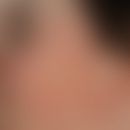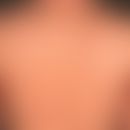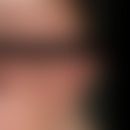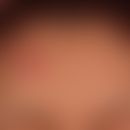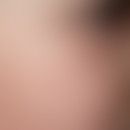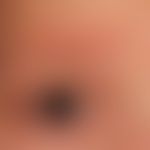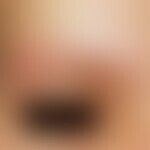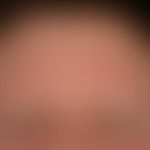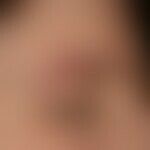Synonym(s)
HistoryThis section has been translated automatically.
Taenzer 1889; Unna 1896
DefinitionThis section has been translated automatically.
Hereditary (or acquired) keratinization disorder with follicular hyperkeratosis, vascular dilatation and consecutive follicular atrophy in the facial region (eyebrows). Hereditary ulerythema ophryogenes is seen as a partial manifestation of the keratosis pilaris group (see the comments under keratosis pilaris syndrome).
You might also be interested in
EtiopathogenesisThis section has been translated automatically.
Hereditary Ulerythema ophyrogenes: Probably irregular autosomal dominant inheritance. To date, the gene locus is unknown. Associations with Noonan syndrome have been described several times. It ends with complete atrichia of the eyebrow region (see Fig.).
Acquired ulerythema ophyrogenes (Frioui R et al. 2021;Jimenez-Cauhe J et al. 2021): The occurrence of ulerythema ophyrogenes during therapy with nilotinib has been described several times.
ManifestationThis section has been translated automatically.
Occurring in childhood or early adulthood. The disease can extend over an entire lifetime.
LocalizationThis section has been translated automatically.
ClinicThis section has been translated automatically.
Always appearing symmetrically on both eyebrow regions, two-dimensional, initially limited to the lateral eyebrows, saturated red, asymptomatic, scaling erythema with 0.1 cm follicularly bound hyperkeratoses.
Prolonged persistence, with persistent areal redness, results in gradual loss of the eyebrows, starting laterally. The hair follicles also disappear completely.
Over the course of years, analogous atrophic processes may also occur at the forehead-hair junction(alopecia postmenopausal frontal fibrosing) and in the cheek area (see erythema perstans faciei below). In the cheek area, a saturated red, symmetrical, persistent, two-dimensional erythema appears.
Concomitant: Commonly keratosis pilaris in the extremities (Coelho De Sousa V et al. (2018).
Additionally concomitant, although less frequent, is the appearance of comedones and pustules(Ulerythema acneiforme).
HistologyThis section has been translated automatically.
Differential diagnosisThis section has been translated automatically.
Complication(s)(associated diseasesThis section has been translated automatically.
Flat alopecia of the eyebrows.
External therapyThis section has been translated automatically.
Since this is a harmless disease with essentially cosmetically disturbing changes, only mild external therapy attempts should be applied. Restrained and only short-term use of glucocorticoid-containing externals!
Keratolysis: In hyperkeratotic areas, keratolytic externals (see keratolytics) such as 3-10% salicylic acid ointments/gels/colloids R215 R216 R227 (do not get on mucous membranes or eyes) or 0.05-0.1% vitamin A acid cream (e.g. R256, Cordes VAS cream) should be tried. Hydration with alpha-hydroxycarboxylic acid, lactic acid (e.g. Episoft A) and/or urea preparations(e.g. Ureotop, Carbamide, Calmuride).
Anti-inflammatory: glucocorticoids locally in fatty externals such as 0.25% prednicarbate (e.g. Dermatop Fatty Ointment), 0.1% methylprednisolone (e.g. Advantan Ointment) combined with urea and lactic acid containing preparations (e.g. Remederm, R104 ). Alternatively: combinations with hydrocortisone and urea (e.g. Hydrodexan). Glucocorticoid-containing intralesional injections with triamcinolone (e.g. Volon A crystal suspension or triamcinolone Lichtenstein diluted 1:3 with LA such as scandicaine) are also possible. Caveat. Painful!
Care: Accompanying refatting oil baths (e.g. Lipikar, Balneum Hermal, Linola Fett N).
Hair area: Incipient alopecia are irreversible, therefore early therapy with e.g. intralesionally applied glucocorticoids, see above. In the final stage, hair replacement if necessary.
Internal therapyThis section has been translated automatically.
Progression/forecastThis section has been translated automatically.
Chronic insidious course over decades (completely resistant to therapy). Sympotmatism improves only with increasing age. The process leads to irreversible (scarring) alopecia of the eyebrows.
Note(s)This section has been translated automatically.
Ulerythema ophryogenes may occur as a partial manifestation of Noonan syndrome (Li K et al. (2013) .
Keratosis pilaris, ulerythema ophryogenes (keratosis pilaris atrophicans faciei) and monosomy 18p have been described as manifestations of Zoubulis syndrome (Liakou AI et al (2014).
LiteratureThis section has been translated automatically.
- Azambuja R et al (1987) Ulerythema ophryogenes and folliculitis ulerythematosa reticulata. Dermatologist 38: 411-413
- Burnett J W et al (1988) Ulerythema ophryogenes with multiple congenital anomalies. J Am Acad Dermatol 18: 437-440.
- Frioui R et al (2021) Nilotinib-induced keratosis pilaris associated with cicatricial alopecia resembling frontal fibrosing alopecia. Dermatol Ther 34:e14579.
- Guidry JA et al (2013) Ulerythema ophryogenes and Noonan syndrome. Dermatol Online J 19:14
- Jimenez-Cauhe J et al (2021) Keratosis pilaris-like eruption induced by nilotinib. Ital J Dermatol Venerol 156(Suppl. 1 to No. 6):47-48.
- Jerjen R et al.(2021) Ulerythema ophryogenes mimicking frontal fibrosing alopecia. Dermatol Surg 47:1024-1025
- Li K et al. (2013) Ulerythema ophryogenes, a rarely reported cutaneous manifestation of noonan syndrome: case report and review of the literature. J Cutan Med Surg 17:212-218.
- Liakou AI et al (2014) Trias of keratosis pilaris, ulerythema ophryogenes and 18p monosomy: Zouboulis syndrome. J Dermatol 41:371-376.
- Patrizi A et al (2002) Ulerythema ophryogenes and keratosis pilaris. Eur J Dermatol 12: 572
- Snell JA et al (1990) Ulerythema ophryogenes in Noonan syndrome. Pediatr Dermatol 7: 77-78.
- Tänzer P (1889) On ulerythema ophryogenes, a skin disease not yet described. Monatsh prakt Dermatol (Hamburg) 8: 197-208
- Unna PG (1896) The histopathology of the diseases of the skin. Clay, New York, pp. 1086-1089.
Incoming links (23)
Comedonic nevus; Erythema; Erythema perstans faciei; Folliculitis granulomatosa perforans; Folliculitis ulerythematosa reticulata; Frontal fibrosing alopecia; Graham-little syndrome; Keratosis, follicular; Keratosis follicularis spinulosa decalvans; Keratosis pilaris faciei; ... Show allOutgoing links (33)
Acne (overview); Alopecia (overview); Atrophoderma vermiculatum; Erythema perstans faciei; Erythrosis interfollicularis colli; Frontal fibrosing alopecia; Glucocorticosteroids; Granulosis rubra nasi; Hair transplantation; Hyperkeratoses; ... Show allDisclaimer
Please ask your physician for a reliable diagnosis. This website is only meant as a reference.
